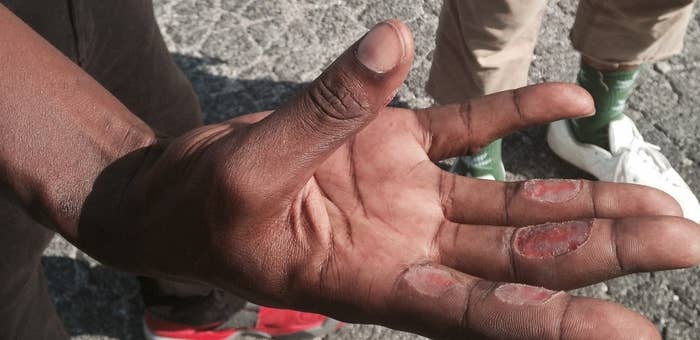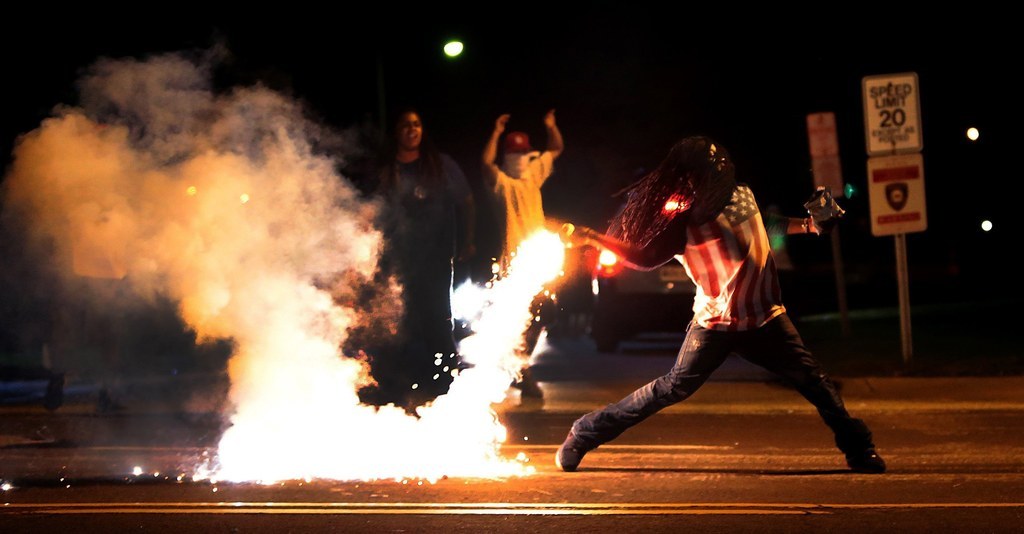
FERGUSON, Mo. — The tear gas canister landed near Clarence Bledsoe's feet at about 10 p.m. Sunday night. He hadn't been looking for a fight with officers, he said, but was simply walking home after a long day of work and had little choice but to wade through all the pandemonium to get to his apartment. But when the hissing projectile narrowly missed him, all of the anger of the past week welled up within him.
Bledsoe bent down and picked the canister up, ignoring the searing heat in his right hand.
"I felt like, 'Y'all shooting at me? I'm just trying to get home,'" Bledsoe said. "I picked it up and threw it back. I never, ever, ever pictured myself throwing something at the police."
After officer Darren Wilson killed Michael Brown, the protests in Ferguson developed a distinct rhythm: They grew younger and testier as the night wore on and as older demonstrators and families went home. Many of the young protesters yelled the now familiar chant, "Hands up! Don't shoot!" But many of them also yelled, "Fuck the police." And they didn't just hurl curses; they also threw empty liquor bottles, rocks and, more than once, live tear gas cannisters that had been shot at them.
Missouri Highway Patrol Capt. Ronald Johnson, who was placed in charge of the police response last week, called them "outside agitators." State Sen. Maria Chappelle-Nadal, whose district includes Ferguson, referred to them as "fools." Gov. Jay Nixon said they were "a dangerous element" who managed to derail the earlier peaceful protests. "We've seen the divide between protesters and … those other forces," Nixon said Thursday.
They've also been blamed for the riots and subsequent looting that prompted the heavy police response and that led to boarded-up storefronts along the once-bustling retail corridor of West Florissant Avenue. And, no doubt, some of them did partake in looting, though some also helped guard neighborhood shops.
But mostly they are young black men and some women from Ferguson and the surrounding inner suburbs of St. Louis who see themselves in Brown — not just because he was 18 and black, but also because they have their own tales of being harassed by the police. They're groups of friends, mainly, with no single leader, and organized only by an emotion: anger. So when police officers have told them to get off the street or move out of a parking lot, they have often responded by spitting out, "Fuck you!" or picking up a full water bottle and flinging it at the cops.

On the morning Brown was killed, Bledsoe and his friend Steve Statom were moving into their new apartment in Canfield Green.
As they unloaded their truck and carried their belongings into the apartment, they heard gunshots. When they came outside, Brown's dead body was lying in the middle of the street that runs through the complex.
Anger at Brown's death surged almost instantaneously. A number of videos — many of them halting and macabre — show people crowding the police tape, gawking at the body, and muttering curses at officers working the scene.
"Mike ain't have no felonies. He ain't have no warrants. He ain't have nothing," Statom said. "If Mike had been white, he would have been tasered," not shot.
With a boost from social media, word of mouth, and local hip-hop radio stations, news from Canfield Green reached people throughout the St. Louis area.
By the end of the day, dozens of protesters — most of them young — had already made their way into town. "I've been down here since the first day," said Dontey Carter, a 23-year-old from St. Louis. "We all had the same pain and anger about this. We all came together that day." Carter carried a sign that read, simply, "Civil Rights Movement." And he calls himself a "civil rights leader."
But Carter doesn't look like a traditional civil rights demonstrator. He wore a green-and-white striped du-rag with matching green shorts and shoes. Pulling his black T-shirt over his head revealed a heavily inked torso featuring tattoos that read "Heaven" across his chest and "Hell" on his stomach. Just over his right eyebrow there's another tattoo: "Mr. Carter."
On West Florissant Avenue, Carter blended right into those late-night crowds that were awash in tattoos, gold teeth, shirtless torsos, sagging pants, and red, blue, or black bandanas wrapped around mouths and necks. Many of the people on the streets were high school dropouts. Some had already served time in jail or prison. At least a few were gang members.
Perhaps the icon of their fledgling movement is a dreadlocked man identified on Twitter only as @eyeFLOODpanties, who was photographed throwing a tear gas canister while wearing an American flag T-shirt and holding a bag of potato chips. The picture, taken last week by the St. Louis Post-Dispatch's Robert Cohen, has inspired countless T-shirts and posters. "I didn't realize how big this was!" he tweeted after his identity was revealed and he gained thousands of Twitter followers.

Indeed, they are the sort of people rarely given a national stage. One in four Ferguson residents lives in poverty, and nearly half of the town's young black men are unemployed. "There's a war against us," Bledsoe said. "We don't see justice at all."
These young protesters share most of the same concerns of the older, more-restrained protesters who arrived early and marched in orderly formations around the broad concrete sidewalks along West Florissant. Both groups want an indictment of Officer Wilson for Brown's death; a crackdown on police departments that engage in racial profiling; more black officers at local police departments; and, more generally, better schools and more job opportunities.
In less-tense moments — usually early in the evening — religious leaders, established community activists, and elders of the neighborhood attempted to reach out and counsel younger members of the crowd. Often the generation gap was too wide.
"They're always angry — and with good reason," said Antonio French, a St. Louis alderman who's risen to national prominence for his role in the protests. "When your local government goes to war with you, you're talking about introducing a match to a pool of gasoline."
"But," he said, "it's our responsibility to talk to them and teach them how to get that anger out in a constructive manner."
French recalled a conversation with a particularly agitated teen during an early protest. "I was trying to hold him back, and he was screaming at us peacekeepers, saying that we should be with him. And I told him I was with him and that I was trying to keep him safe. He said, 'French, they ain't throwing nothing but rubber bullets and tear gas.' They think it's just a game."
At least one older protester argued that time has dimmed the more provocative aspects of the civil rights era. "I was around in the '60s," said Johnny Williams, who grew up in Memphis, Tenn., but now lives in St. Louis. "We were much more physical, and there was much more looting."
In at least the case of Carter, the pleas for a more peaceful type of protest fell on deaf ears. He said his peers are looking for new leaders, not the ones who marched peacefully and got — as he sees it — few returns for their efforts.
"I feel in my heart that they failed us," he said. "They're the reason things are like this now. They don't represent us. That's why we're here for a new movement. And we have some warriors out here."
That stance — and the police response — has led to confrontations, arrests, tear gas, and smoke bombs along West Florissant.
Last weekend, when tensions were at their highest, the clashes followed a pattern: The most aggressive protesters would edge close to a line of officers, raise their hands — symbolizing the position witnesses claim Brown assumed when he was shot — and chant, "We are Mike Brown," and "We ready. We ready. We ready for y'all!"
Police in riot gear, including gas masks, helmets, and rifles, would then use armored vehicles, smoke bombs, and tear gas to break up the crowd. The subsequent commotion almost always allowed for some protesters to throw bottles or rocks. Capt. Johnson has also said several protesters fired their handguns or tossed Molotov cocktails at the officers.
"We had a subject standing in the middle of the road with a handgun," Johnson said after a protest last Saturday. "We had a police car shot at tonight."
During the protests, some people shouted comments such as, "We got guns, too," and "Let's bang it out." But none of the young protesters interviewed by BuzzFeed News endorsed initiating violence against the police, let alone shooting at them. But they insisted officers were the cause of all the trouble.
"I don't know why people can't see that," said Quentin Baker, a 19-year-old who lives in the southern part of St. Louis County but has come out to protest every night. "All of these things happen after the police provoke it. What they want to do is impose their will. The media isn't showing them and what they're doing."
At this point, there's not much more to show. The protests have slowly petered out, and the police presence along West Florissant has steadily decreased. On Thursday, for the first time in more than a week, no demonstrator was taken into custody.
Carter said he plans to continue protesting, even if the media and police move on, until there's a resolution in the case against Wilson. "They're killing us, and it's not right," Carter said. "And I'm coming out every day until I hear 'guilty' or 'not guilty.'"
Bledsoe, who burned the skin off three of his fingers and part of his hand when he tossed that tear gas canister back at the police, said he's also not going to waste this moment, because he has a 3-year-old son, and his fiancé is pregnant with twins.
"We live in a war zone right now," he said. "I want to make sure I can live here safely with my kids."
